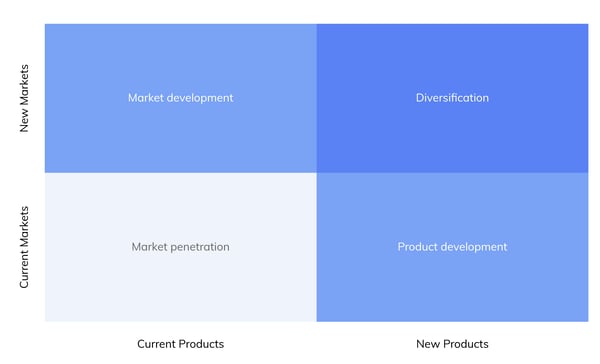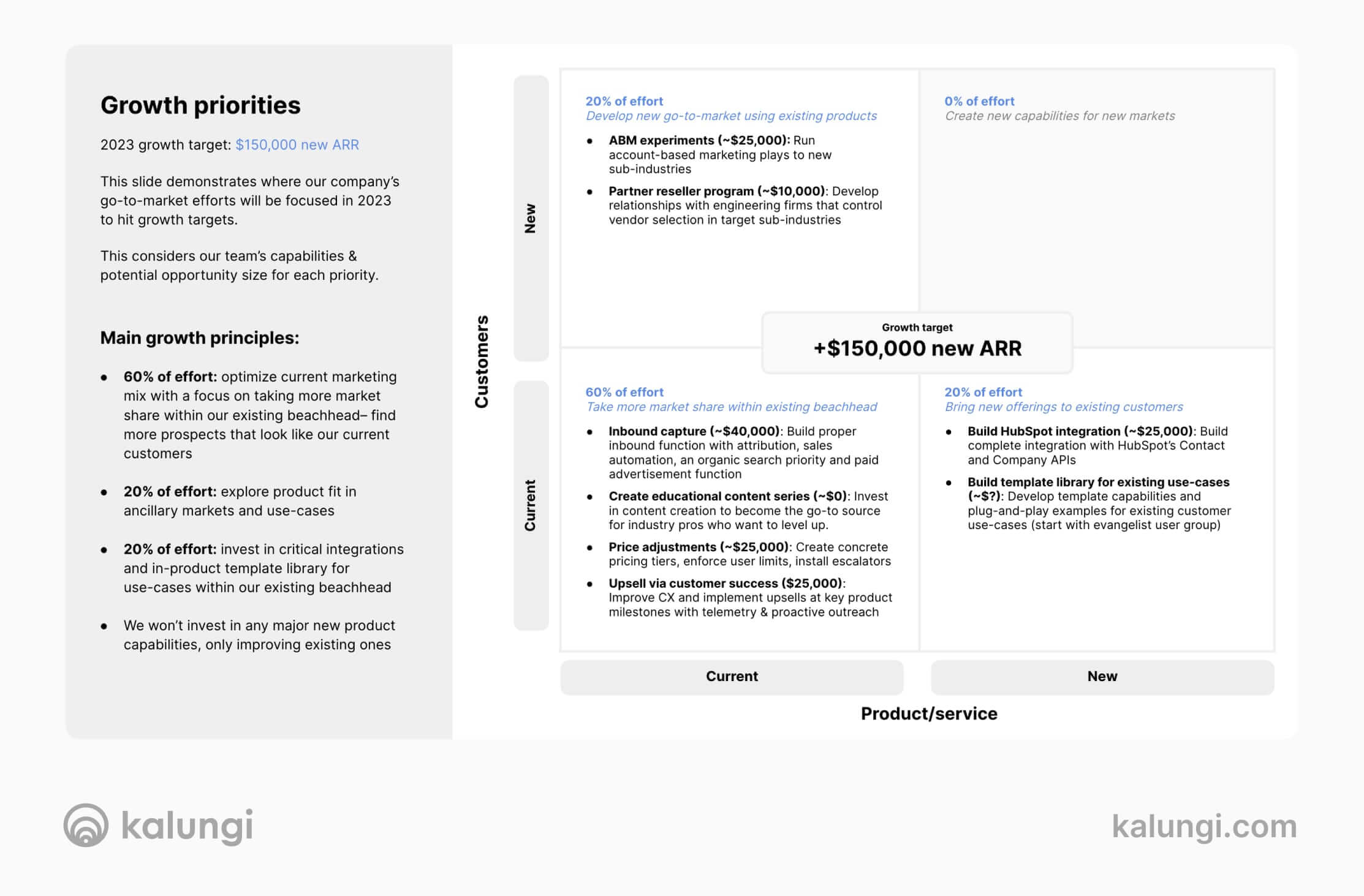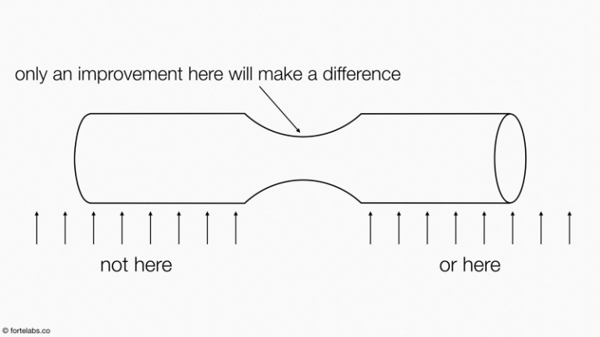Build your first plan with this sample SaaS marketing budget strategy
You raised money and can hire your first Marketing leader. Check this sample saas marketing budget plan to push the right efforts and get a huge...

So your B2B SaaS company has a great product and has decided to use marketing to facilitate its growth. That’s a fantastic idea! We think that getting a great marketing department up and running is pivotal in facilitating exponential growth for your company. However, for your marketing department to be successful, its goals have to closely align with your company’s strategy. This concept may seem obvious but it can be very difficult to implement if you don’t align the two early.
In our interactions with clients, we’ve seen that a lot of this difficulty stems from poor communication across verticals or assumptions that are made on what each division knows. So we’ve set up a process to push the right information to the forefront and to transform it into actionable goals and bold but attainable results. This process incorporates Ansoff’s growth matrix, Objectives and Key Results, and the Theory of Constraints. Our combination of frameworks focuses our clients' attention in the right areas and ensures that we can build our marketing departments quickly and in lock-step with our clients’ business priorities.
First up, leadership alignment. In order to move forward and grow the way you need to, the leadership team needs to be completely aligned on the company’s goals and vision for the future. This gives the rest of the organization’s leader the tools to make clear decisions about the work they pursue to support that vision.
To help with this, we suggest having a discussion with your leadership team to hash out the following questions as a group. Setting aside time and energy to really focus on answering these questions is crucial to facilitating the growth of your company and it allows everyone a voice in the matter. What comes out of those discussions can be incredibly meaningful and gives everyone a clear view of what the goals are and how to achieve them.
What is your product and what industry challenges does it solve (claim)? What are your customer personas whose challenges you’re solving? What about your Ideal Customer Profile?
What are the pain points of your customers? What is your company's story? Do you still uphold the reasoning behind why you do what you do? What are the benefits of your product (gain)?
What do you want to achieve? Higher ROI? MQL and SQL specifics? Customer specifics? SEO ranking?
What marketing strategies are you going to implement? How many and what campaigns will you run? What will your inbound and outbound teams focus on?
Now that you’ve aligned your leadership team, you need to figure out what’s next. Where are you now? What industry do you serve, what customers do you have? Where would you like to be? Are there any new markets you’d like to dive into? Any new customers worth touching? To help with this, we use Ansoff’s matrix.
Ansoff’s matrix was developed in 1957 by Igor Ansoff, a notable mathematician. The matrix provides a simple way to visually gauge both development and risk assessment, making it a useful tool to analyze and plan your Go-To-Market strategy. It breaks down the expansion process into 4 main areas.

Though there’s room for interpretation (some “business moves” may be subjective and difficult to place in only one section), the matrix illustrates that growth out of the “comfort zone” involves risk as well as reward. Moving into a new market, or developing a new product, brings medium risk. Making a leap into totally new territory (new market/new product) brings with it the highest risk - and possibly, the highest reward.
Now that you’ve solidified your go-to-market strategy, it’s time to put your planning to use! It is crucial that your entire team is completely aligned with the new strategies and understand what actions need to be taken to help deliver on them – the initial time spent on ensuring your team understands what the next phase of the company is well worth the investment, this ensures that they can execute on appropriate tasks to get there.
The final output of your growth matrix exercise should be a slide that lives in your go-to-market summary deck and guides your leadership team's priorities. It might look like the image below.
If you'd like to create something like this for your team, check out our step-by-step guide on facilitating a growth matrix exercise.

It is beneficial to prioritize the results of your matrix and tackle the low-hanging fruit. Acting on your current market and current products – market penetration – is the easiest way to get started and can be used as a short-term goal. This quadrant will specifically focus on developing your marketing and sales strategies to help achieve those goals. Consider working on redeveloping your messaging with another matrix focused on product features.
The other quadrants would require a more significant lift from the whole team as well as a significant investment of time and money into R&D for products and markets. As a result, these would likely be your longer-term strategies, so carefully thinking and planning about the next steps will ultimately lead to greater success in your strategy.
Consider tying in your strategic goal setting initiatives. A successful one commonly used by countless B2B SaaS companies is Objective Key Results (OKRs). Consider developing new OKRs around your new-found strategy to help keep the team laser-focused on actions to help support your strategy – that way, every action from the team has a purpose. It can also help remove distractions when faced with a dilemma between multiple options.
The Ansoff Matrix is a strategic planning tool, and like most tools it is better used in conjunction with other strategic planning tools, like the SWOT analysis (which we will be talking about next time) or the Theory of Constraints, a business management framework that focuses on systematically resolving small constraints to improve outcomes. While the Ansoff Matrix helps you define your goals and outline how to achieve them, the Theory of Constraints helps you achieve those goals more effectively and more efficiently by focusing on the constraints, i.e. the smallest problems that have the biggest impact.
Every goal is a series of interlinked activities. In theory, given that each of these activities has an efficiency rating, one of them will inevitably be the least efficient, i.e. be a constraint, a bottleneck, the weakest link. Dr. Eliyahu Goldratt’s Theory of Constraints is a methodology that aims to systematically pinpoint and resolve the current constraint, which will make another activity the new constraint, etc.

To prevent limiting factors from inhibiting goal completion, the Theory of Constraints comes with a set of tools:
TOC is great in environments that require rapid and perpetual improvement because it inherently focuses on improvement activities by making each current constraint more efficient.
It can result in:
In a B2B SaaS context, successful TOC implementation can have positive impacts on the development, marketing, and sales functions:
TOC can work alongside Agile and Lean methodologies as well. With that in mind, it’s important to not fall into the trap of improving every problem, including those that are not constraints because improving every problem won’t necessarily improve the system
The Theory of Constraints uses the five following steps to identify and resolve the bottlenecks:
The Theory of Constraints touches on a lot more, including Lean, Gemba, Kaizen, Kanban, and a lot more, which are all worth reading up about for more information.
Learning about the Theory of Constraints along the Ansoff matrix is useful because using multiple tools in combination allows for a more holistic approach, which is less prone to blind spots and more rigorous in its attempt at achieving optimal outcomes.
Especially for marketing, keeping a keen eye on potential constraints can have huge and immediate positive impacts on your marketing function.
(To learn more about the Theory of Constraints, check out this article.)
Building your marketing strategy from scratch can be a daunting task. You must not only closely align your strategy with your company’s current and future goals but you must also create a strategy that can be quickly implemented and gives your team the ability to make a sustained impact for your company. Using Ansoff’s matrix in a brainstorming session with your executive leadership team is a fantastic way to prioritize your Go to Market strategies and align marketing with the rest of the company.
However, it’s one thing to build a good strategy and another to successfully implement and manage it. Consider using frameworks such as Objectives and Key Results as well as the Theory of Constraints to build a management system that gets results. These frameworks will ensure your team is laser-focused on driving the results that matter, while you can focus on removing blockers and increasing the efficiency of your team.
If you are interested in learning more about the best ways to kick-off and manage your new marketing team, please take a look at some suggested readings below:
Brian is the CEO of Kalungi. Brian has successfully led B2B SaaS clients in all aspects of marketing growth as a fractional CMO. He also has an MBA from the UW Foster School of Business with a focus in finance and marketing.
You raised money and can hire your first Marketing leader. Check this sample saas marketing budget plan to push the right efforts and get a huge...
Discover why CMO-as-a-Service is the smarter, faster path to B2B SaaS market leadership. Learn how on-demand marketing leadership drives growth.
Learn B2B Saas thought leadership's pivotal role in marketing strategy and how you can leverage it to create unbeatable sustainable results.
Be the first to know about new B2B SaaS Marketing insights to build or refine your marketing function with the tools and knowledge of today’s industry.